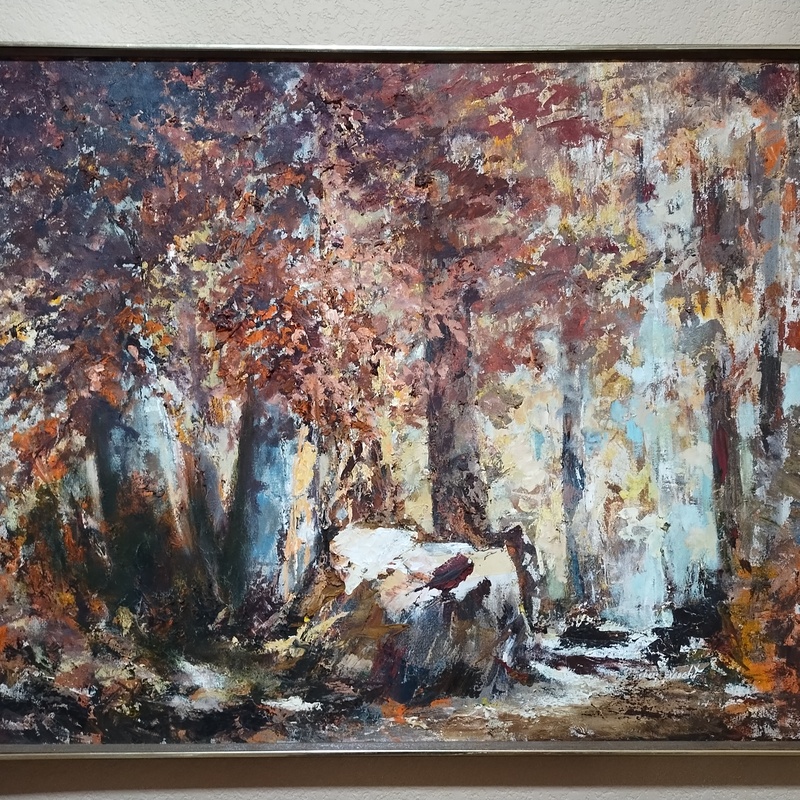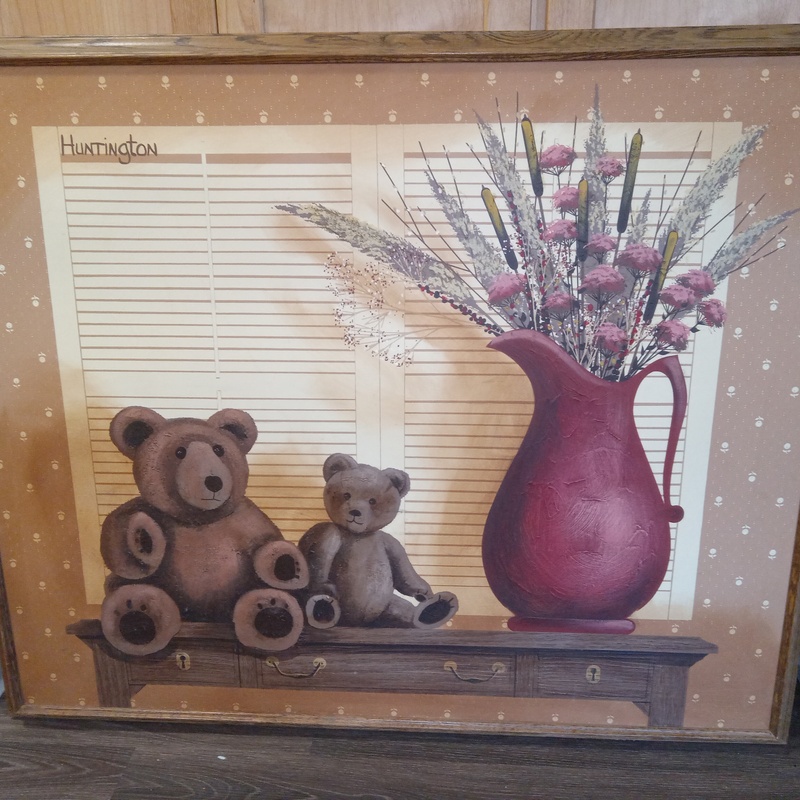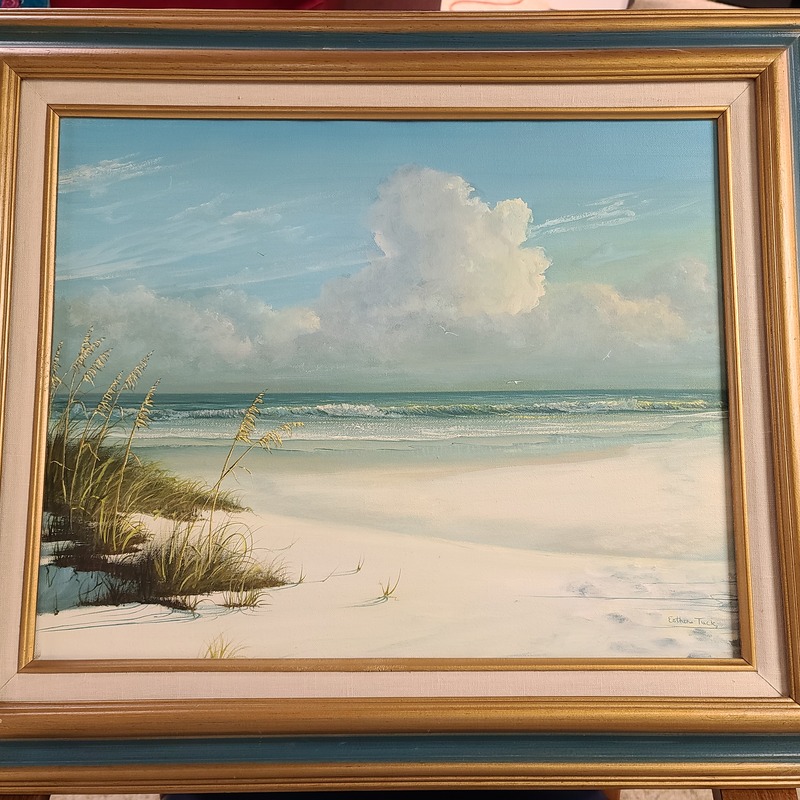
Gibbon with Her Babies on Rockwork, by Lee Man Fong (1913 – 1988)
Note: I can not upload the Certificate of Authenticity and provenance documents and photos in PDF file. ================= This piece was appraised by ValueMyStuff.com in 4th November 2015. ============ 1. RESEARCH & ESSAY ================ The painting art can be traced back to pre-historic periods, which the human's fingers were used as a paintbrush on the cave walls. When it comes to a steady movement of painting art world in nineteenth century, Indonesian artists learned and mastered the styles of European painting. Watercolors is one the most frequently medium to use, and their works bare the gorgeous landscape and romantic themes, which was similar to European paintings. ================ In modern era, there were numerous talented watercolor artists in Indonesia, and they increased on daily basis in the post-war II eras. However, there was a unique style of painting that combines the European art techniques with Chinese art format, like what a Chinese-born artist, Lee Man Fong executed on the present work. This artist’s oeuvre was considered as one of the newly born works in post-war era influenced by ink philosophy, Western technique of oil on canvas, and social change of surrounding environment composed in Chinese art format. The present painting brings the viewers closer to a sublimity taste, and it is that this aesthetic legacy also shares the traditional Chinese painting format and Western technique with an effusive cultural Chinese message. ================ Entitled “Gibbon with Her Babies on Rockwork”, Lee Man Fong meticulously painted the animals by featuring their short tail, long hands, and the body is covered with white-shaded beige fur, while the upper side of its head and face are painted in blackish. Two large gibbons are depicted in squatting on an oak tree branch and precipitously rocks, which one of them shows enfolding her baby and another biting the food. Large rock and oak trees around them are depicted in whitish green-shaded dark with the green and beige background. On the upper right of the painting, the artist writes his signature in black Chinese character with a red square seal mark, while red rectangle seal mark is also written on the upper right side. ================ Born in Guangzhou, China, in 14th November 1913, Lee Man Fong trained both in China and in Western Europe. He lived much of his life in Indonesia, and developed a principally style that blends together a variety of sources for his quite yet passionate vision. Like the present work, the artist frequently turned Chinese brushwork and technique in Nanyang style, but he depended on Western visual practices. The present work certainly was completed after the artist studied the original works of European masters such as Rembrandt van Rijn and Vincent van Gogh when he received the Malino scholarship to Netherlands. Like the present work painted in 1964, Man Fong blended Western art technique with Chinese painting art format expressing a tendency to create the atmospheric effect prevalent in Chinese style ink on paper paintings. To show characteristic taste of Chinese arts, Man Fong embellishes the flavor of tastes by applying the xieyi free-hand style to the twigs of the trees, emitting natural result of the beauty. The artist then combines it with a careful realist style or Gongbi style on the animal figures that represent the beauty of art in Western technique of oil on canvas. ================ On the present work, the artist also composes the multiple representations of perspective creating a dynamic composition that encompasses the viewer in full. The focal point on the present work is not fully the landscape, but it is that of animals in nature around rocks, and trees depicted in crisp detail scrutinizing the viewers of this work. By gazing into the focal point, the figures of gibbon transform from crisp detail to soft brushstrokes on background that establish linear depth. Lee Man Fong experimented with Eastern-style oil painting at the age of 25 in 1937 and decisively committed himself to the incorporation of eastern elements in his paintings in the 1940s. The gibbon’s images are depicted in detail and beautifully full of allure. The gibbons are exquisitely rendered, and the technique of laying on paint or pigment are applied thickly so that it stands out from a surface glaring a great sense of verisimilitude. They are also depicted colorfully alive, vividly realistic and capable of evoking intense emotions despite some parts of old tree and its twigs on this work are painted in slightly simple narrative. The artist set the varied poses of gibbons with their realistic expressions and actions that are complemented by the expressive texture of fur rendered ingeniously with light and dark as well as wet and dry application of paint. The brushstrokes for the oak trees branch and precipitously rock in the setting are also exhibited in natural and precise format. ================ By taking the Chinese root sources of his works frequently, Lee Man Fong represents the subject on this work that gibbon on the present work is cultural symbol of wealth and abundance and celebrated as one of its most important animal symbols. As one of the painter's favorite animal painting subjects, the gibbon or apes is a Chinese cultural symbol of fun, activity, charm and an energetic nature and it is celebrated as one of its most important animal symbols. In his considerable oeuvre, Lee Man Fong oftentimes created a significant number of animal paintings which express the importance and continuing relevance of Chinese culture and its meaning in his life and works. ================ The gibbon or monkey is considered as one of important subjects playing the significant roles in Chinese culture for over two thousand years. The pictorial painting depicting the gibbons were available on Chinese hanging scroll ink on silk in the Southern Song dynasty (1127 – 1279 AD). For example, a Hanging Scroll ink on silk entitled “A Gibbon with Her Baby on A Pine Branch”, was painted by the Chinese artist Muqi (1210 – 1269 AD) during Southern Song dynasty (see fig. 1).1) In the Ming dynasty, the gibbon images also appeared on the handscroll paintings on paper. See the scroll entitled “Gibbons at Play” was painted by the Xuande emperor of Ming dynasty in 1427 AD, and now is in The National Palace Museum, Taipei (see fig. 2).2) The Xuande Emperor of Ming dynasty was known as an accomplished painter, particularly he was skilled at painting animals like the gibbons on the present work. ================ The visualization of the subject on this work indeed exceptionally draws people’s attention to Lee's ability to be a talent artist presenting the animal life in teaching affection, yearning and relationship care for human life. Man Fong also reveals the legend of gibbon as the symbol of the power of innovation and being able to quickly solve the problems as well as conceive how to socialize well in order to be able to achieve their goals expeditiously. Gibbon has become Lee’s beloved and highly sought-after work in Europe and Hong Kong. However, the subject depicting the gibbons like on the current Lee Man Fong’s work is extremely rare for its medium of oil on canvas, as opposed to Lee's more common working in oil on masonite board. The present work painted oil on canvas is exceptionally one of the most celebrated Lee’s gibbon paintings derived from ancient Chinese “gibbon” handscroll paintings of all times of his life and career. The artist’s work painted oil on canvas were completed albeit in a small number, and it was sought-after by collectors. ================ Citation: 1. Gibbon paintings in China, Japan, and Korea: Historical distribution, production rate and context, Gibbon Journal Nr. 4 – 2008, Thomas Geissmann, Anthropological Institute, University Zürich-Irchel, Winterthurerstr. 190, CH–8057 Zürich, Switzerland, 2008, p. 2. ================ 2. The gibbon in China: an essay in Chinese animal lore, Robert Hans van Gulik, E.J. Brill, Leiden, Holland, 1967, p. 95.
Height : +/- 77.5 cm ===== Width : +/- 69 cm
2. PROVENANCE ================ PROVENANCE OF ARTWORK: Lo Wing Tjong (1851 – 1934) to Liem Guan Kwee (22th September 1901 – 25th March 1985) to Liem Syuhada (12th June 1927 – 22nd April 2000) to Current Owners (Descendants) ================ The present painting was acquired directly from the artist, Lee Man Fong, in 28th October 1964 in Jakarta by Liem Guan Kwee (22th September 1901 – 25th March 1987), a son of Lo Wing Tjong (1851 – 1934), a Diplomat and Chinese community leader in Batavia under Guangxu reign (1875 – 1908) of China. The acquisition of the present piece was a final period of Lee’s dedication as a Presidential Palace painter (1961 – 1966) and one year before a massive hunt and eventual killing of Indonesian communists and their sympathizers in 30th September 1965. Liem Guan Kwee witnessed the history of event how the turmoil of Indonesian political life during the Old Order Government, the first President Soekarno, and New Order Government, the second President Soeharto in 1965 – 1966. ================ In 2001, the present artwork was researched and authenticated by team of National Archaeology, Art and Culture Foundation in person deriving from Southeast Asia artworks, paintings and Chinese ceramics experts. The foundation itself was led by Professor Abu Ridho, an Asian art scholar and consultant, former curator of National Museum of Jakarta – Indonesia, and author of Chinese art books. The physical examination of this artwork and its authenticity is certified on an official letter of statement and agreement that was signed by professor and legalized by public notary ‘Royani, SH’, dated 8th April 2002. In 2004, the government of Republic of Indonesia recorded this legacy especially regarding with its authenticity, historical artwork and the ownership of property or legal rights. This artwork was appreciated and archived officially as a national cultural heritage object by Culture and Museum Agency of Government of Indonesia, Jakarta, number 863/-1-853.3, dated 14th April 2004. ================ In 2018, this artwork that had been signed by Prof. Abu Ridho on Certificate of Authenticity, the present work was also re-researched by one of great grandsons, Faisal Hasan, who was graduated from Master of Art (MA) Program of LASALLE College of the Arts – Singapore with subject of Asian Art Histories. The great grandson re-examined and re-analyzed this artwork by more elaborate manner. This re-examination includes its technical or stylistic analysis, documentary research and comparison with similar artist or periods. All of them are relied on archives, art libraries and reputable art and antique commercial institutions or auction houses enabling to strongly establish its eligible quality and authenticity. ================ All documents and photos of its provenance and certificate of authenticity are included in separated page. ================
Inherited
Yes


Dear Faisal,
Thank you for your help and patience. My sincere apologies for the delay with the apprisal.
The presented object appears to be a painting oil on canvas with the measurements of 77,5 x 69 cm. This painting depicts two gibbons eating fruits. This painting has the title: Gibbon with Her Babies on Rockwork. It appears to get made, signed, and has the seal by Lee Man Fong (1913 – 1988). It comes from a private collection.
Comparable objects were recently offered and sold on the international auction market.
This piece is in good condition and there is no severe damage visible in the images provided.
A fair market estimation for an authentified artwork by Lee Man Fong would be between 25.000 to 50.000 USD.
This estimate is based on actual recent past recorded auction sales of comparable items. Retail "asking prices" can be higher and may vary.
An artwork of such high potential value requires further authentication research. This estimate is provided on the condition of authenticity.
With kind regards,
George









